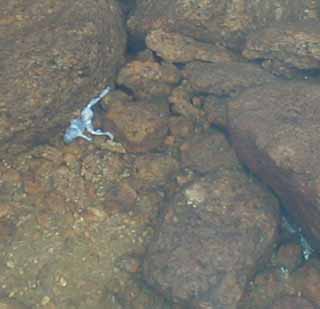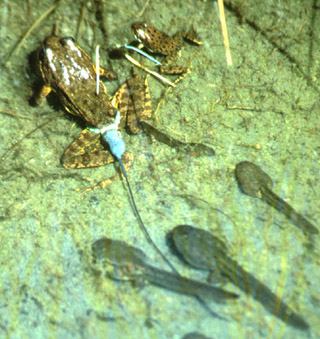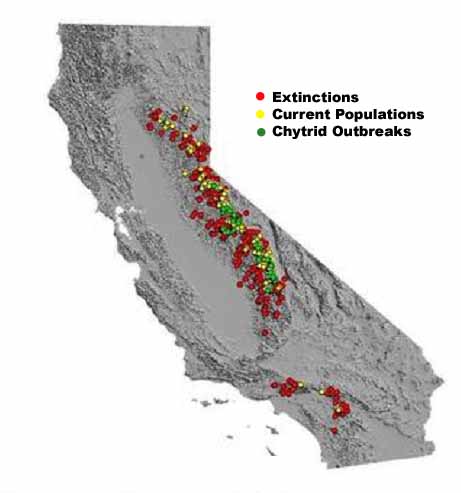With Recovery Efforts Underway, Danger still exists for the frogs
by Peter Stekel
 |
| Yellow-legged frog dead of Chytrid fungus near Mt. Whitney, Sequoia National Park. |
At one time, the
mountain yellow-legged frog (Rana muscosa) was one of the most common vertebrates
in the high elevation aquatic ecosystems of the Sierra Nevada and Transverse
Ranges of southern California. Then came the well-documented decline in the
species that occurred with the introduction of non-native fish. The fish,
primarily trout, ate frog tadpoles in large numbers. And now, an emerging
infectious fungal disease, chytridiomycosis, has created another threat to
the frog’s survival.
Chytridiomycosis is caused by the pathogenic fungus, Batrachochytrium dendrobatidis.
Found in the skin of frogs and in the mouthparts of tadpoles, the fungus has
created severe impacts on amphibian populations around the world. While tadpoles
can carry the fungus without any known health consequences, the disease can
kill adults.
Vance Vredenburg, a research scientist at the Museum of Vertebrate Zoology
at UC Berkeley says there is no known non-aquatic life stage of the Chytrid
fungus - it’s only spread from water source to water source. “How
it got to the Sierra Nevada is the million dollar question.”
Sierran frogs are severely affected. “There has been something like a
25-30% decline in populations over the last five years due to fungus,” says
Vredenburg. It’s ironic that fish removal has allowed mountain yellow-legged
frog populations to recover and now Chytrid fungus threatens to knock them
down.
Maybe Chytrid fungus has always been present in Sierran waters and recently
become pathogenic. If true, researchers hypothesize that sensitivity to
airborne industrial and agricultural contaminants has compromised the frog’s
immune system and made them susceptible to fungal infections.
 |
| Healthy tadpoles,
juvenile and adult Mountain Yellow-legged frogs (with radio tracking
band) Photo © Vance Vredenburg |
However it got here, Vrendenburg says the mechanism Chytrid fungus uses to
kill frogs is unknown. Since it grows in the skin of the frog, one idea is
that it causes asphyxiation. Frogs breathe through their skin. If their skin
is covered, they suffocate. Another idea is that the fungus produces a toxin
that then kills the frog.
The real danger of Chytrid fungus lies in how isolated frog populations
have become. “Frog populations are on the edge already, says Vrendenburg. “Genetic
variability is low and the species ability to fight this infection is low,” Had
this disease hit a hundred years ago, when mountain yellow-legged frog populations
were more numerous and contiguous, “Maybe theweaker
individuals would have died, leaving the stronger ones to carry on.” But not anymore. “These
small populations are dropping like flies.” At the headwaters
of the Kern, in Milestone Basin, researchers found hundreds of dead
and dying frogs last summer in what was once a healthy and expanding
population.
Vrendenburg looks positively to the future. “We’ve discovered populations
that are surviving the Chytrid fungus and have bounced back. They appear to
have some kind of resistance to the fungus.” He also stresses the success
land managers have experienced in re-establishing frog populations. “This
shows the value and importance of the fish removals and that they need
to go on - creating more habitat for these frogs to help them fight
this disease.”
 |
As
if the froggies weren't having enough problems: Chytrid outbreaks in
Mountain Yellow-legged frog populations in California as of 2004. |
This article first appeared in a different format in Sierra
Heritage magazine.
Further Reading
Rana
muscosa:
Mountain Yellow-legged frog (Amphibia Web) includes photos, sound recording
of call, life history and research papers.
The Mountain
Yellow-legged Frog: Can They be Saved?
by Vance Vredenburg, Ph.D
A Summer Spent Saving Frogs:
Applying Research to the Real World
by Ryan Peek
Biology Department, UC Davis
FOLLOWING
THE FROGS The
continuing effort to find and save the mountain yellow-legged frogs
of the Sierra Nevada
by Casey Ray
Field Biologist,
Sierra Nevada Aquatic Research Lab (SNARL)
The AmphibiaWeb Watch List (extinct, missing or endangered amphibians of the world, with map).
The
Mountain Yellow-legged Frog is Recovering in Sequoia and Kings Canyon National
Parks
by Peter Stekel
Our Founder Questions? Go to About Our New Site |
Masthead
Photo from: |